Metro Ethernet
Metro Ethernet is an Ethernet transport network that provides point-to-point or multipoint connectivity services over a metropolitan area network (MAN). Ethernet originated as a LAN technology, and became a replacement for low-speed WAN technologies. BTC Metro is based on Multi-protocol label switching (MPLS) Technology, this technology enables faster delivery of data across the Metro network using labeled data packets.
This is a a point to point metro connection between two or more sites such as Data Centres. This connection can support speeds from 1M to 10G, 40G & 100G to be supported in future
Metro Ethernet connection options
E-LINE: Normally referred to as Point to Point connection, connects point “A” to Point “B”.
E-LAN: Normally referred to as Multipoint to Multipoint connection, each site communicates to another without going through the HQ.
ETREE: Normally referred to as Hub and Spoke, all services have to pass through the HQ before going to final destination.
MPLS Layer 3 VPN: uses a peer-to-peer model through a Border Gateway Protocol (BGP) to distribute VPN-related information. Routing information is outsourced to service providers.
METRO ETHERNET USE CASE 5 -E-TREE
Remote site connectivity to data centers
- Enterprises often require connectivity from their remote sites to one or more Data Centers.
- Connect Core DC to remote DC’s
- Data mirroring, replication or backups
- Connect distributed LAN’s
- Network resource sharing
- High speed connectivity
- Network redundancy
- Service convergence
- Network resiliency
- Guaranteed QoS
- Government & Corporates
- EVC can connect a number of sites in a tree format
- One or more roots can transmit data to a number of leaves
- Root to Leaf communication provided intrinsically by the network
- Enterprise can define number of roots and leaves as well as bandwidth assigned to each
- Independent streams can be configured between the same set of sites in order to segregate traffic
METRO ETHERNET USE CASE 4 -E-LAN
LAN Extension
As businesses expand, branch offices will be opened in different places with their own LAN. These distributed LAN’s will need to be connected together so that resources can be shared. E.G. for remote video monitoring, distance learning and business continuity/disaster recovery.
- Data mirroring, replication or backups
- Connect distributed LAN’s
- Network resource sharing
- High speed connectivity
- Network redundancy
- Service convergence
- Network resiliency
- Guaranteed QoS
- Government & Corporates
- Intra and inter-DC communications
- Eliminates Point To Point connections
- No single point of failure
- Ease of LAN add or removal
- high availability
METRO ETHERNET 2-E-LINE
Connecting multiple data centers
These technologies have been used for building WAN connections but they can not offer speeds comparative to those offered by metro Ethernet. Cloud services are pushing these technologies to the limits due the demand for high broadband and high transmission speeds.
- Connecting more than one Data Center (DC)
- Guaranteed traffic parameters
- High speed connectivity
- Guaranteed Quality of Service (QoS)
- Government & Corporates
- Point to point services retained
- Demands for increasing bandwidth easily met
- Cost saving as there is no additional OpEx & CapEx like in legacy technologies
- High speeds supported from 1M, 10G to be supported in future 40G, 100G
- Supports high availability
